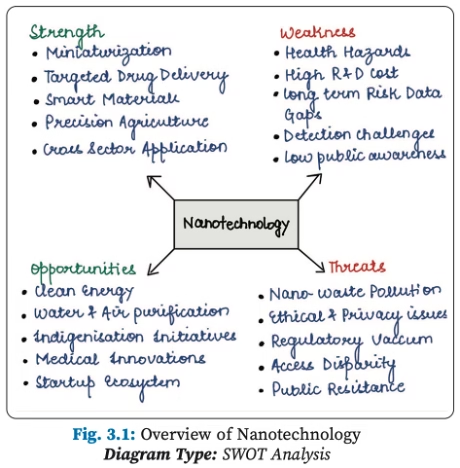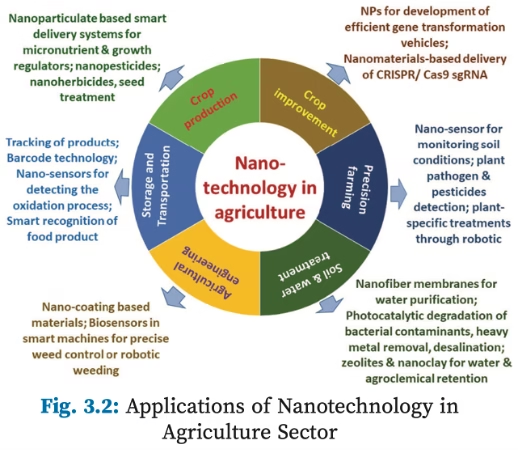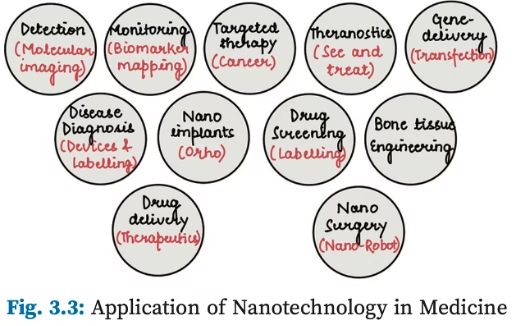We are Launching Live Zoom Classes for 9th and 10th-grade Students. The first batch is from 7th April 2025. Register for a Free demo class.
Nanotechnology
Introduction
- Nanotechnology, also known as nanotech, is a field of technology focused on controlling and manipulating matter at incredibly small scales, specifically at the atomic, molecular, and supramolecular levels.
- It encompasses the ability to work with particles ranging in size from 1 to 100 nanometers.
Applications of Nanotechnology
Agriculture:
- Introduction of nano urea for fertilizer delivery, nanosensors for precision farming, and nano-processing techniques in farming. e.g, Nano Urea.
- Nanocapsules facilitate the efficient entry of herbicides, chemical fertilizers, and genes into specific plant areas
Food Industry:
- Nano-enhanced barriers are effective in preserving the freshness of oxygen-sensitive food.
- Nano-encapsulation techniques can enhance the solubility of essential elements such as vitamins, antioxidants, and healthy omega-3 acids.
- Nanobarcodes play a crucial role in tagging individual products and tracing outbreaks for improved product safety and accountability.
Health Sector:
- Nanoparticles, with their exceptional precision, have become pivotal in drug delivery systems.
- Quantum dots are used in medical imaging for precise diagnostics.
Textiles and Fabrics:
- Silver nanoparticles embedded fabrics remain fresh and odor-free even after intense workouts.
- Nanoscale Silica or fluorocarbon-coated fabrics repel water and stains, keeping them clean and dry.
Electronics and Semiconductor Technology:
- Mobile: Nanotechnology has created smaller, powerful transistors and sensors for smartphones. Nanomaterials enhance energy storage, benefiting portable electronics devices.
- Semiconductor Sector: Nanotechnology has helped in miniaturizing electronics for smaller, faster, and more portable devices.
Environment:
- Nanotechnology has facilitated environmental conservation and is helping in the transition to sustainable energy. Nanomaterials like perovskite significantly boost solar panel efficiency.
Space Sector:
- Nanotechnology is instrumental in creating lightweight solar sails for propulsion, as demonstrated by NASA’s NanoSail-D2 mission.
- Nanotechnology addresses temperature regulation by employing nano-coatings and phase change materials to manage spacecraft temperatures in the space environment.
Advantages of Nanotechnology
- Enhanced Material Properties: Nanotechnology allows for the creation of materials with improved strength, flexibility, and conductivity, leading to advancements in various industries such as electronics, aerospace, and healthcare. E.g Carbon nano-tube.
- Improved Energy Efficiency: Nanotech enables the development of energy-efficient devices and systems, leading to reduced energy consumption and environmental impact.
- Targeted Drug Delivery: Nanoparticles can be designed to deliver medications directly to specific cells or tissues, increasing treatment efficacy and minimizing side effects.
- Water and Air Purification: Nanoparticles can be designed to deliver medications directly to specific cells or tissues, increasing treatment efficacy and minimizing side effects. E.g Cancer Treatment Using Liposomal Nanoparticles
- Information Technology: Nanomaterials can effectively remove pollutants from water and air, contributing to cleaner and safer environments. Eg. Titanium Dioxide (TiO₂) Nanoparticles.

Challenges Related to Nanotechnology
- Health Concerns: Nanoparticles can potentially enter the human body through inhalation, ingestion, or skin contact, raising concerns about their long-term effects on health.
- Environmental Impact: There release could result in formation of a new class of non-biodegradable pollutant and interfere with the functioning of the ecosystems.
- Ethical Considerations: Issues related to privacy, surveillance, and the equitable distribution of benefits and risks.
- Unknown Risks: Due to the relatively new nature of nanotechnology, there are still uncertainties surrounding its potential risks, necessitating further research and assessment.
- Manufacturing Hazards: The production of nanomaterials may involve the use of toxic substances, posing risks to workers and the environment if not properly managed.
- Lack of Information on the nature and characteristics of nanomaterials, insufficient methods for detecting and measuring nanomaterials etc.
- High costs for acquisitions of IPR, nanotechnology infrastructure etc.
Indigenization of Nanotechnology
The indigenization of technology in the nanotechnology sector represents a transformative shift, fostering self-reliance and innovation within indigenous communities.
- Government Initiatives: In 2001, the Department of Science and Technology (DST) launched the Nano Science and Technology Initiative (NSTI) to foster research and development in nanotechnology.
- Nanomaterials and Nanodevices: Carbon Nanotube Filters from Banaras Hindu University, Typhoid detection kit using nano sensors.
- Entrepreneurship and Startups: Nanoshel, an Indian startup is actively commercializing Nanotechnology products for aerospace, automotive, and electronics industries.
- Nanotechnology in Agriculture: Nanofertilizers, nanosensors for crop monitoring, and nanocoatings for pest control are being explored to enhance crop productivity and reduce environmental impact.
- Energy Advancements: Tata Chemicals’ nanotech based energy storage system can store up to 10 times more energy than traditional counterparts.
Conclusion: Nanotechnology in India holds promising prospects for the future. With advancements in research, development, and applications, it has the potential to revolutionize various sectors such as healthcare, electronics, energy, and materials. India’s commitment to this field paves the way for innovation, economic growth, and societal benefits.
Nanotechnology in Agriculture
Context: Recently, Fertilizer cooperative Indian Farmers Fertilizer Cooperative Limited (IFFCO), has received approval for Nano Zinc and Nano Copper liquids under the Fertiliser
(Control) Order, 1985 (FCO).
Applications of Nanotechnology in Agriculture
- Nano Fertilizers: Nanocapsules facilitate the efficient entry of herbicides, chemical fertilizers, and genes into specific plant areas, ensuring a controlled and gradual release of essential substances while minimizing environmental impact. Example: Nano urea by IFFCO
- Nano Pesticides formulations enhance solubility, dispersion, target-specific delivery and efficiency compared to conventional pesticides. Example: Copper nanoparticles are used as a fungicide.
- Nano-Sensors: Miniaturized optical, electrochemical and magnetic nano-sensors monitor soil quality, crop growth environment, plant pathogens, moisture levels etc. in real-time. Example: Carbon nanotube-based sensors detect ethylene gas released by ripening fruits, helping in post-harvest management.
- Smart Delivery Systems: Materials like nano-porous zeolites, cellulose nanofibers, carbon nanotubes are used for precise delivery of agricultural agents like genes, herbicides, growth hormones etc to enhance the effectiveness. Example: Chitosan nanoparticles delivering DNA or agrochemicals into plant cells for genetic modification or disease resistance.
- Antimicrobial Nano-coating: Silver nanoparticles applied as coatings on greenhouse glass, plastic films, and irrigation pipes prevent microbial buildup.
- This avoids decay and enhances the durability of farming infrastructure. Example: Silver nanoparticle coatings on plastic films in polyhouses inhibit mold and algae growth.
- Plant Disease Diagnostics: Nano barcodes and nanoprobes coated with antibodies detect plant pathogens like bacteria and viruses quickly and accurately compared to conventional techniques. Example: Gold nanoparticle-based biosensors detecting tomato yellow leaf curl virus (TYLCV) in infected plants.
- Seed germination: Nano priming of seeds with zinc, titanium dioxide, and silica nanoparticles speeds up germination rates and plant growth by penetrating the thick seed coat and enhancing enzyme metabolism.
- Nano-coatings on fruits restrict oxygen and moisture penetration to delay ripening and prevent spoilage during storage.

Key Challenges of Nanotechnology in Agriculture
- Toxicity Issues: The impacts of nanomaterials on soil quality, microbial activity and human health require more evaluation through life cycle analyses.
- Nanomaterials reaching the land have the potential to contaminate soil and migrate into surface and ground waters.
- Financial Constraints: The R&D and specialized manufacturing systems required to engineer nanoproducts make initial investment prohibitive for small companies.
- Production Challenges: Many nanomaterials are currently produced only in small, laboratory-scale quantities.
- Regulatory Roadblocks: Regulatory uncertainty due to lack of standardized safety data and nano-specific regulations deters commercialisation.
- Interdisciplinary Skills Deficit that bridges nanoscience, agriculture, and food technology.
Government Initiatives on Nanotechnology in Agriculture
- Nano Mission: Nanotechnology research centers like the Centre for Nano Science and Engineering (CeNSE) has been launched at IISc Bangalore, which works on nano-fertilizers and nanotech food packaging.
- ICAR Initiatives: The Indian Council for Agriculture Research established Nanotechnology Centres at IARI and IVRI to develop nano-biosensors, nano-pesticides, and nanocapsules for nutrient delivery.
- Nano Urea: IFFCO placed India first in the world in Nano Urea and Nano DAP production.
- Nano Urea is sprayed not on the ground but on the plants, which leads to a zero possibility of destruction of natural elements or earthworms present in the soil.
- Nano-fertilizers: IARI developed nanoparticles of zinc, chitosan, and silica as nano-fertilizers for improving crop growth and yield.
Way Forward
- Investment in R&D: To address challenges like scalability, toxicity concerns, and production efficiency.
- Foster collaboration between academia, government, and industry to accelerate innovation in nanotechnology for agriculture.
- Regulatory Framework Development: For the safe use and commercialization of nanomaterials in agriculture.
- Encourage private sector involvement: Through incentives and partnerships to scale up production and commercialization of nano-enabled agricultural products.
- Monitoring and Evaluation: Establish monitoring systems to track the environmental and socioeconomic impacts of nanotechnology adoption in agriculture.
Nanotechnology in Health (UPSC 2020)
In 2024-25, India made significant strides in advancing nanotechnology for healthcare applications, with several research initiatives focused on drug delivery systems, cancer treatment, and diagnostic tools, ex: use of liposomal nanoparticles.
- These developments align with India’s broader goals of improving affordable healthcare and precision medicine, leveraging nanomaterials to revolutionize patient care and disease management.
Applications of Nanotechnology in Health and Medicine
- Diagnostics: Nanodevices and nanoparticles, like quantum dots and nanocrystals, are used for early detection and diagnosis of diseases. Example: Gold nanoparticles used in rapid COVID-19 test kits.
- Drug Delivery Systems: Nano-liposomes and other nanocarriers target specific cells or tissues, improving drug efficacy and reducing side effects.
- Nanoparticles encapsulate medication, delivering it directly to cancer cells with minimal damage to healthy tissue. Example: Abraxane – For breast and Lung cancer treatment.
- Smart pills with embedded sensors for real-time monitoring and drug release performs advanced functions like sensing, imaging, and drug delivery.
- Nanorobots are used for targeted drug delivery and surgery at the cellular level.
- Regenerative Medicine: Nanotechnology is employed in developing materials for tissue engineering, such as scaffolds that mimic biological tissues, aiding in tissue repair and regeneration.
- Pharmaceuticals: Nanoparticles improve the pharmacokinetics of drugs, increasing their solubility, stability, and bioavailability, which allows for lower dosages and reduced toxicity. Example: Nanocurcumin – a nano-formulation of curcumin (turmeric).
- Nanofibres are used in wound dressings, surgical textiles, implants, tissue engineering, and artificial organs. They have enhanced healing properties and are “smart bandages” with sensing capabilities. Example: Silver nanoparticle-infused bandages used for burn wounds and diabetic foot ulcers.

Challenges of Nanomedicine
- Biocompatibility: The interaction of nanoparticles with cells and biological systems can sometimes induce toxicity, leading to potential health risks.
- Targeting Accuracy: While targeted delivery is a major advantage of nanomedicine, achieving precise targeting to diseased cells without affecting healthy cells remains a significant challenge.
- Bioaccumulation: Nanoparticles tend to accumulate in organs like the liver, spleen, lungs and brain. However, the long-term effects of such accumulation are not known.
- Interference: Some nanoparticles suppress the immune system, while others may be toxic to the immune cells. Their effects on the complex immune signaling pathways are still being studied.
- Cost barriers: High costs due to complex production requirements and uncertainty about insurance coverage and reimbursement levels restrict access and mainstream use.
Conclusion: Nanotechnology will provide promising therapies to cope with various severe diseases, and will also provide tools to solve the various bottlenecks in healthcare sectors. However, different nanomedicines and nanoformulations targeting various diseases must be meticulously designed in order to achieve the safest and most efficacious therapeutic regimen.
| Previous Year Questions | Year |
|---|---|
| What do you understand by nanotechnology and how is it helping in the health sector? | 2020 |
| Why is nanotechnology one of the key technologies of the 21st century? Describe the salient features of Indian Government’s Mission on Nanoscience and Technology and the scope of its application in the development process of the country. | 2016 |
